|
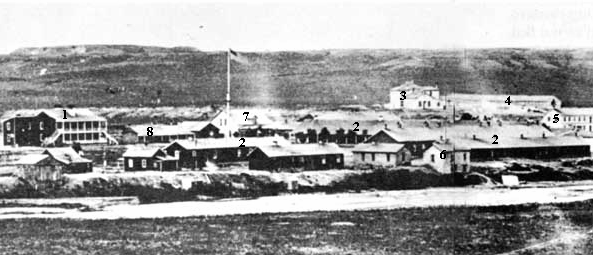
Fort Laramie, 1876
1. Old Bedlam, 2. Infantry Barracks, 3. Post Hospital, 4. Stables, 5. Cavalry Barracks,
6. Old Guard House, 7. Post Surgeon's Quarters, 8. Magazine.
An 1875 visitor to the fort, Laura Winthrop Johnson, described the fort under the military:
A description of this fort will do for all the rest, though this is one of
the oldest, largest and most important posts. There is no sort of
fortification whatever: a large parade-ground, nearly destitute of
grass and planted with half-dead trees, is surrounded by the barracks
and quarters, neat, low buildings, and beyond, at one end, are the
ordnance and sutler's stores. A hospital and a large old barrack called
Bedlam tower above the rest: more buildings straggle away toward the
Laramie River, where there is a bridge. The position commands the river
and bluffs. No grass, no gardens, no irrigation, no vegetables nor anything
green is here. One good-sized cottonwood, perhaps coeval with the post,
seemed as much of a veteran as the old artilleryman, a character always
pointed out to strangers, who has lived at the post ever since it was a
post, and is distinguished as the ugliest man there. His seamed and scarred
face looks as if it had been through many storms and many Indian fights.
Another distinguished character is the pet elk, a privileged person, who
abuses his privileges by walking into houses and eating up hats, shoes,
window-curtains, toys—anything to satisfy his voracious appetite.
[Writer's note: "coeval," of the same age.]
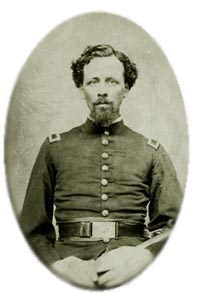
Levi H. Robinson
An inportant, although routine, portion of military life at western forts was the laying in of
wood for use as fuel for heating. Wood details were frequent. Fort Laramie was served by a
pinery located near Laramie Peak to the west of Ft. Laramie. There the government
maintained a sawmill. The wood would be brought back to the fort by wood trains with
military escort. On February 9, 1874, the wood train escorted by a detail under Lt.
Levi H. Robinson was attacked by Indians from the Red Cloud Agency. Lt. Robinson was killed. To bring
matters under control, units were dispatched from Ft. Laramie northward to northeast Nebraska.
Near present-day Crawford, Nebraska, an encampment named after Lt. Robinson
was established. With the arrival of the soldiers, as will be discussed later, rebellious Indians withdrew from the
Pine Ridge Agency and moved westward into the Big Horns and to Powder River. Later that year, G. A. Custer, in
violation of the Treaty of Ft. Laramie, led an expedition into the Black Hills. On July 30, 1874, a member of the expedition, Horatio Nelson
Ross, discovered gold in French Creek near present-day Custer, S. Dakota. Six days later, Ross with others posted the first
mining claim in the Black Hills. Notwithstanding his discovery of gold, Ross died pennyless near his discovery at Custer City in 1905.
A scout was dispatched by Custer to Ft. Laramie to deliver word of the discovery
by telegraph to the remainder of the world, setting off a gold rush to the Dakotas.
This, in turn set the stage for a further military expeditions northward in an effort to bring the Indians back onto their
reservations.
In 1878, Camp Robinson was renamed as Fort Robinson and gradually grew.
In 1886, the Fremont, Elkhorn & Missouri Valley Railroad pushing its was westward toward
Wyoming reached Fort Robinson. In 1889, the Chicago, Burlington & Quincy also reached the
area. With rapid transportation available to Fort Robinson, the determination was made that Fort Laramie,
once the most important military post on the Great Plains, was to be
abandoned in favor of Fort Robinson. Gradually in the summer and autumn of 1889, units from Ft. Laramie were withdrawn. Five companies of
the 7th Infantry under the command of Col. Henry C. Merrian were reassigned to Fort Logan, Colorado. On April 7, 1890,
the buildings at the fort were sold at public auction.
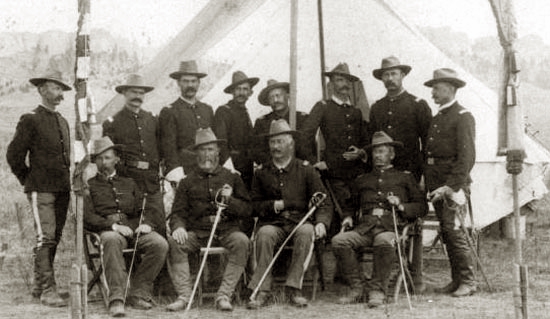
Last Cadre of Officers Seventh Infantry, Ft. Laramie, September, 1889
Left to Right, seated: Lt. Charles A. Booth, Capt. Levi Frank Burnett, Col. Henry C. Merrian, Major Andrew Burt.
Standing: Lt. L. D. Greene, Lt. George Wilcox McInver, Capt. William Quinton, Lt. Alred B. Johnson, Capt. Louis Brechemin (Post Surgeon),
Lt. Armand I. Lasseigne, Lt. A. P. Buffington, Lt. D. L. Howell.
[Writer's notes:
Booth, Burnett, Johnson, and McIver all served as a part of John Gibbon's column from Ft. Shaw as a
part of the Campaign of 1876. Booth was was a part of the military which protected the Chinese at the time
of the Rock Springs Massacre in 1885. Lt. McIver served as one of the last commanding officers of
Ft. Laramie from March 2, 1890 until April 7, 1890. Col. Merrian served as commanding officer from
October 5, 1888 until October 17, 1889, when five companies of the 7th Infantry were transferred to
Fort Logan. In 1890, after Wounded Knee, the units were transferred to Fort Robinson. Capt. Brechemin later was
at San Francisco at the time of the Earthquake and was in charge of distribution of medical supplies using a
circus tent. As noted, the photo has been dated as of September 1889 which would mean that it would have been taken at
Fort Laramie. However, the photo has also been identified as being taken at
Fort Robinson. The background appears similar to Fort Robinson. Booth at time of the photo may have achieved his
captaincy. He was a lieutenant in 1885 and by 1894 was a captain.]
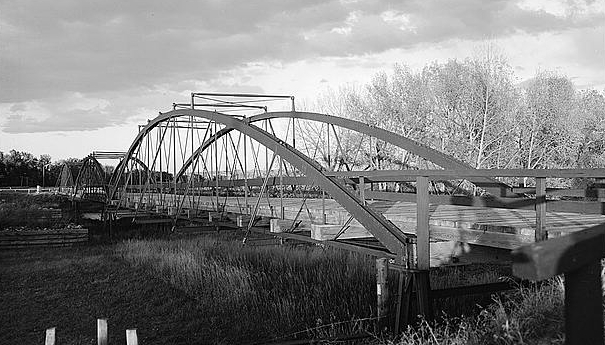
Fort Laramie Military Bridge
Military Bridge photos courtesy Library of Congress, Prints and Photographs Division
Fort Laramie until the coming of the railroads was also a center point in communication between
Fort D.A. Russell at Cheyenne and northern posts including Fort McKinney and Fort Robinson. It connected those forts
by telegraph to military headquarters. In the 1880's the military telephone line proceeded northward from the fort.
Through the fort Gen. George Crook marched as a part of the 1876 three-pronged attack on Sitting Bull of which
George Armstrong Custer was to serve as one prong. The Military Bridge, therefore, made communication easier.
The above-view is of the northwest side of
the bridge. Lower photo is looking northwest.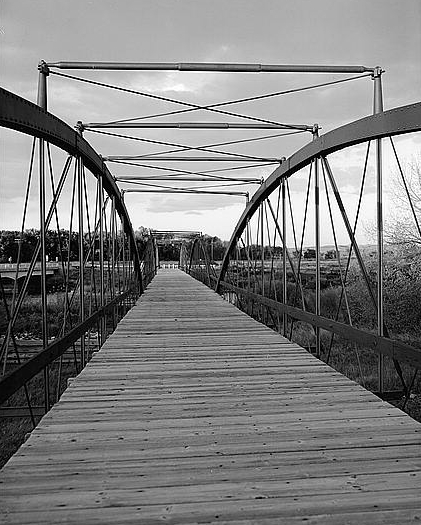 By 1873 Cheyenne had become a center for freighting.
Concern grew, however, that because of difficulties in crossing the North Platte that
freighting might move to other cities on the Union Pacific that did not have
such difficulties. When Laramie County refused to construct a bridge, the
territory's congressional delegate, William Randolph Steele (1842-1901), see text below,
secured the support of Secretary of
War Belknap for a bill requiring the military to build a bridge. Orders for
the construction of the bridge were issued the day after President Grant signed the bill. By 1873 Cheyenne had become a center for freighting.
Concern grew, however, that because of difficulties in crossing the North Platte that
freighting might move to other cities on the Union Pacific that did not have
such difficulties. When Laramie County refused to construct a bridge, the
territory's congressional delegate, William Randolph Steele (1842-1901), see text below,
secured the support of Secretary of
War Belknap for a bill requiring the military to build a bridge. Orders for
the construction of the bridge were issued the day after President Grant signed the bill.
The Fort Laramie Bridge was constructed by the King Iron Bridge and Manufacturing Co. of
Cleveland, Ohio between July 1875 and February 1876 at a cost of $10,500.
The bridge provided easy access for the military to points north of Ft. Laramie and was
also used by freighters and by the Deadwood stage. At the north end of the
bridge was located a log stage station owned by John Montgomery. When the Deadwood
Stage discontinued operations he sold the facility to Whipple & Hay. Whipple & Hay were
wholesale grocers who also ran cattle in the area.
The bridge is
the oldest existing military bridge west of the Mississippi. The last military unit was
withdrawn from Fort Laramie on March 2, 1890. Thereafter in 1894, the bridge was
turned over to Laramie County.
Maintenance was assumed by newly-formed Goshen County in 1911. The bridge remained
in use until completion of a new concrete bridge in 1958, visible at the left in the above photo. In 1961, the
bridge reverted back to the United States which continues to maintain it under the
United States Park Service. 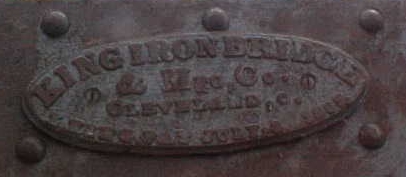
Name Plate, Ft. Laramie Military Bridge, 2001, Photo by Geoff Dobson
Zenas King (1818-1892) began the construction of steel bridges in 1858. As indicated on
the name plate, he received a patent in July, 1865, for a tubular "bowstring" bridge, of
which the Ft. Laramie Bridge is an example. In 1871, the business was formally incorporated as
the King Iron Bridge and Manufacturing Company. By the 1880's it was the largest
bridge manufacturing company in the United States. In addition to bridges, the
company manufactured fencing, trusses, and jail cells. Among other notable bridges it
manufactured were the 591 ft. Detroit-Superior Bridge and the 1,339 ft. Danville, Pa.
"Great Bridge" which remained in service until recently. The Company was dissolved in the
1920's.
Steele, a Democrat, served as a captain during the Civil War and was awarded the brevet
rank of Lt. Colonel. A lawyer, he moved to Wyoming in 1869 and served in the
Territorial Legislative Council from 1871 to 1873. until he was elected as concressional
delegate. He was defeated for reelection in 1876. He thereafter moved to Deadwood where he
served as mayor 1894-1896. Upon the formation of South Dakota he declined the Democratic
nomination as congressional delegate.
Next Page: Ft. Laramie Continued, Privies, Restoration of buildings, Sutler's store, Old
Bedlam continued.
|